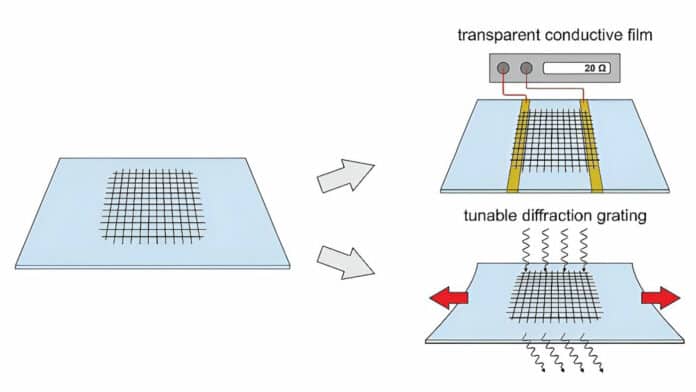Researchers from Skoltech, MIPT, and other institutions have discovered a new, affordable method of creating intricate geometric patterns on carbon nanotube films. The resulting films exhibit exceptional properties, making them ideal for manufacturing components for 6G communication devices, as well as wearable health trackers and flexible and transparent electronics.
Carbon nanotubes have various levels of organization, with a single-walled nanotube being comparable to a 2D sheet of carbon atoms (graphene) rolled into a cylinder. These cylinders can stick together to form thicker fibers, which can then interconnect into a large, porous 3D network that can coat surfaces as a thin layer. By removing some of the material from the film, scientists can impose a geometric pattern on it, further modifying the film itself.
“Our team came up with a very efficient way to do this and used it to create a mesh-shaped carbon nanotube film. This used to be achieved by literally burning many holes in a film. The idea is to make the film more transparent at the cost of some electrical conductivity. We end up with a transparent conductor that can bend, and that is basically the definition of an optical electrode for flexible transparent electronic devices, such as biosensors that monitor the wearer’s heart rate, breathing, and blood oxygenation,” study co-author Assistant Professor Dmitry Krasnikov of Skoltech Photonics said, adding that the mesh structure can also serve as a diffraction grating – a component potentially useful in 6G signal reception.
Currently, there are two primary approaches to creating patterned carbon nanotube films. One of them involves producing a continuous film and then burning holes into it, which can result in wasting up to 90% of the material and is not very cost-effective.
The other method is to use lithography to manufacture the patterned film from the ground up, which can be quite complex and costly. This approach involves multiple steps and the use of liquid solutions, which tend to contaminate the film with impurities and compromise its properties.
“Our approach has a number of advantages,” the study’s principal investigator, Professor Albert Nasibulin of Skoltech Photonics, explained. “It is reproducible, fairly fast and inexpensive, and versatile. No liquid solutions are used, which makes the method cleaner and ensures high quality. In fact, the transparency-conductivity ratio of the mesh – which is its chief figure of merit as far as optical electrodes go – is 12 times better than that of a continuous film. On that account, the new technique outperforms fine lithography and is on par with the comparatively wasteful approach where you burn away – and lose! – the extra material. Also, we can create patterns other than meshes, too.”
The process of creating patterned carbon nanotube films involves several steps. First, researchers create a copper template of the desired pattern, such as a square mesh, by using a laser to cut it from copper foil. They then take a nitrocellulose membrane filter and cover it with the copper template, followed by sputtering copper particles onto it to create a complementary pattern.
When carbon nanotubes are deposited onto the filter, they assume the intended mesh pattern because the sputtered copper particles repel them. The resulting patterned film is easy to transfer to another substrate simply by pressing a piece of rubber, glass, or other material into the filter.
Scientists have tested the diffraction properties of the gratings created through this process, which were prepared as 2D meshes on a thin layer of elastic material (elastomer). A terahertz spectrometer was used to register the diffraction peaks, which were observed in the THz frequency band and correspond to wavelengths of about 1 millimeter, intermediate between infrared light and microwaves.
The researchers stretched the elastic substrate to vary the grating period and registered the associated diffraction peak shifts in strict conformity with known optical laws.
“The ease, simplicity, and relatively low cost of manufacturing structures based on nanotube films, combined with the efficient quasi-optical THz spectroscopy method (using incident THz radiation beam in open space) enable vast opportunities for manufacturing and testing the performance of all sorts of two-dimensional structure based on nanotubes, which could be incorporated in various devices and components using THz radiation,” commented study co-author Boris Gorshunov, who heads the Terahertz Spectroscopy Lab at MIPT.
The team is planning to conduct further experiments using different geometric patterns, such as concentric circles and spirals, for advanced THz imaging. This technology is safe and non-invasive and is commonly used in security screening and medical exams. It relies on radiation in the frequency band between microwaves and infrared light.
Journal reference:
- Ilya V. Novikov et al, Fast liquid-free patterning of SWCNT films for electronic and optical applications. Chemical Engineering Journal, 2024. DOI: 10.1016/j.cej.2024.149733
